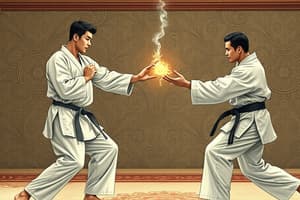Podcast
Questions and Answers
What is the primary purpose of karate stances?
What is the primary purpose of karate stances?
- To develop muscle memory
- To provide stability and support for various techniques (correct)
- To enhance mobility in combat
- To intimidate opponents
What is the main argument against karate stances in modern sparring?
What is the main argument against karate stances in modern sparring?
- They are not effective in self-defense
- They are not visually appealing
- They are not suitable for group practice
- They can make practitioners less mobile and more vulnerable to attacks (correct)
What is the primary purpose of katas in karate?
What is the primary purpose of katas in karate?
- To enhance physical fitness
- To improve mental discipline
- To develop a move directory or library of techniques (correct)
- To simulate combat situations
What is the primary benefit of sparring in karate?
What is the primary benefit of sparring in karate?
What is the ultimate goal of karate practice?
What is the ultimate goal of karate practice?
What is the purpose of katas in relation to self-defense?
What is the purpose of katas in relation to self-defense?
What is the primary benefit of sparring in karate?
What is the primary benefit of sparring in karate?
What is a common criticism of karate in relation to self-defense?
What is a common criticism of karate in relation to self-defense?
What is the purpose of katas in karate?
What is the purpose of katas in karate?
What is an essential aspect of making karate an effective form of self-defense?
What is an essential aspect of making karate an effective form of self-defense?
How can karate practitioners adapt their techniques to be more effective in self-defense?
How can karate practitioners adapt their techniques to be more effective in self-defense?
What is the underlying principle that applies to both katas and sparring in karate?
What is the underlying principle that applies to both katas and sparring in karate?
Study Notes
Karate: Stances, Katas, Sparring, and Self-Defense
Karate is a martial art that originated in Okinawa, Japan, around 1750 AD. It is known for its focus on physical and mental discipline, self-defense, and the use of the body as a weapon. The practice of karate has evolved over the centuries, with various styles and methods developed to enhance its effectiveness.
Stances
Karate stances are designed to provide stability and support for various techniques, such as punches and kicks. They are often low and wide, which can make practitioners less mobile and more vulnerable to attacks, especially in modern sparring where mobility is crucial. While some argue that these stances are not ideal for sparring or self-defense, they serve a purpose in training and can be adapted to suit different situations.
Katas
Katas are a series of choreographed movements that are practiced solo or in groups before sparring with opponents. These movements are designed to develop muscle memory, coordination, and balance, as well as to teach techniques for self-defense. Some argue that kata is not effective for fighting or self-defense, but advocates of the practice claim that it is a tool for developing a move directory or library of techniques, which can be used in various contexts.
Sparring
Sparring in karate is a controlled exercise that simulates combat situations. It allows practitioners to apply the techniques they have learned in a safe and controlled environment. While the stances used in sparring may be different from those in kata, the principles of balance and power transfer still apply. Sparring helps practitioners to refine their techniques and learn to react to their opponent's movements.
Self-Defense
Karate is often criticized for not being effective for self-defense, as it emphasizes stances and techniques that may not be practical in a real-life confrontation. However, karate does teach a range of techniques that can be used for self-defense, such as strikes, joint locks, and throws. Practitioners can adapt their techniques to suit different situations and opponents.
In conclusion, while karate stances may not be ideal for modern sparring or self-defense, they serve a purpose in training and developing the necessary skills for combat situations. Katas provide a structured way to learn and practice techniques, while sparring helps practitioners to refine their skills and adapt to different situations. Karate can be an effective form of self-defense when the techniques are applied correctly and adapted to the specific circumstances.
Studying That Suits You
Use AI to generate personalized quizzes and flashcards to suit your learning preferences.
Description
Learn about the basics of karate, including stances, katas, sparring, and self-defense techniques. Understand the importance of each aspect in karate training and how they can be applied in different contexts. Test your knowledge of karate fundamentals with this quiz.




